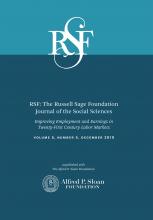Research Article
Open Access
Unions, Worker Voice, and Management Practices: Implications for a High-Productivity, High-Wage Economy
Thomas A. Kochan, William T. Kimball
RSF: The Russell Sage Foundation Journal of the Social Sciences December 2019, 5 (5) 88-108; DOI: https://doi.org/10.7758/RSF.2019.5.5.05
Thomas A. Kochan
aGeorge Maverick Bunker Professor of Management, professor of work and employment research, and codirector of the MIT Sloan School Institute for Work and Employment Research at the MIT Sloan School of Management
William T. Kimball
bPhD student at the MIT Sloan School Institute for Work and Employment Research

REFERENCES
- ↵
- Acemoglu, Daron, and
- Pascual Restrepo
- ↵
- ↵
- Appelbaum, Eileen,
- Jody Hoffer Gittell, and
- Carrie Leana
- ↵
- Ashenfelter, Orley
- ↵
- Ashenfelter, Orley
- ↵
- Arvins, Jeremy,
- Megan Larcom, and
- Jenny Weissbourd
- ↵
- ↵
- ↵
- Benderly, Beryl Lieff
- ↵
- Black, Sandra E., and
- Lisa M. Lynch
- ↵
- Blanchflower, David G., and
- Alex Bryson
- ↵
- ↵
- Bonvillian, William, and
- Peter L. Singer
- ↵
- ↵
- ↵
- ↵
- Brown, Charles C., and
- James Medoff
- ↵
- Brynjolfsson, Erik, and
- Paul Milgrom
- ↵
- ↵
- Card, David
- ↵
- Card, David,
- Thomas Lemieux, and
- W. Craig Riddell
- ↵
- Cengiz, Doruk,
- Arindrajit Dube,
- Attila Lindner, and
- Ben Zipperer
- ↵
- Chamberlain, Neil W., and
- James W. Kuhn
- ↵
- ↵
- ↵
- Deming, David J
- ↵
- DiNardo, John,
- Nicole M. Fortin, and
- Thomas Lemieux
- ↵
- ↵
- Economic Policy Institute
- ↵
- Estlund, Cynthia
- ↵
- Farber, Henry S.,
- Daniel Herbst,
- Ilyana Kuziemko, and
- Suresh Naidu
- ↵
- ↵
- ↵
- ↵
- Freeman, Richard B
- ↵
- Freeman, Richard B., and
- James L. Medoff
- ↵
- Freeman, Richard B., and
- Joel Rogers
- ↵
- Gallup
- ↵
- Gould, Elise
- ↵
- Hirsch, Barry T
- ↵
- ↵
- ↵
- Ichniowski, Casey,
- Kathryn Shaw, and
- Giovanna Prennushi
- ↵
- ↵
- Johnston, Katie
- ↵
- Katz, Harry C.,
- Thomas A. Kochan, and
- Alexander James Colvin
- ↵
- ↵
- Katz, Harry C.,
- Thomas A. Kochan, and
- Mark R. Weber
- ↵
- Kochan, Thomas A
- ↵
- Kochan, Thomas A
- ↵
- Kochan, Thomas A
- ↵
- Kochan, Thomas A
- ↵
- Kochan, Thomas A
- ↵
- Kochan, Thomas A.,
- Harry C. Katz, and
- Robert B. McKersie
- ↵
- ↵
- Kochan, Thomas A., and
- Paul Osterman
- ↵
- ↵
- Kochan, Thomas A.,
- Duanyi Yang,
- William T. Kimball, and
- Erin L. Kelly
- ↵
- Krafcik, John F
- ↵
- ↵
- Lewis, H. Gregg
- ↵
- Lewis, H. Gregg
- ↵
- Lichtenstein, Nelson
- ↵
- ↵
- ↵
- MacDuffie, John Paul, and
- John F. Krafcik
- ↵
- Madland, David
- ↵
- Masters, Marick F., and
- Raymond F. Gibney
- ↵
- Milano, Brett
- ↵
- Milgrom, Paul, and
- John Roberts
- ↵
- National Labor Relations Board
- ↵
- National War Labor Board
- ↵
- Osterman, Paul
- ↵
- Quinn, Robert, and
- Graham Staines
- ↵
- Rees, Albert
- ↵
- Rolf, David
- ↵
- Schmidt, Peter
- ↵
- Slichter, Sumner H.,
- James J. Healy, and
- E. Robert Livernash
- ↵
- U.S. Department of Labor
- Webb, Beatrice, and
- Sidney Webb
- ↵
- ↵
- Western, Bruce, and
- Jake Rosenfeld
In this issue
Unions, Worker Voice, and Management Practices: Implications for a High-Productivity, High-Wage Economy
Thomas A. Kochan, William T. Kimball
RSF: The Russell Sage Foundation Journal of the Social Sciences Dec 2019, 5 (5) 88-108; DOI: 10.7758/RSF.2019.5.5.05
Jump to section
- Article
- Abstract
- COLLECTIVE BARGAINING AND THE POSTWAR SOCIAL CONTRACT
- UNION WAGE EFFECTS DURING THE SOCIAL CONTRACT ERA
- UNION EFFECTS ON PRODUCTIVITY
- UNION EFFECTS ON PROFITS
- THE BREAKDOWN OF THE SOCIAL CONTRACT
- VARIATIONS IN UNION EFFECTS AND THE QUALITY OF LABOR-MANAGEMENT RELATIONSHIPS
- OUT OF THE ASHES: CURRENT STATE OF WORKER VOICE
- EMERGING FORMS OF WORKER VOICE
- IMPLICATIONS FOR POLICY
- STARTING POINTS FOR A NEW LABOR POLICY
- BROADER STRATEGIES FOR IMPROVING JOB QUALITY
- TECHNOLOGY AND THE FUTURE OF WORK
- FOOTNOTES
- REFERENCES
- Figures & Data
- Info & Metrics
- References
Related Articles
- No related articles found.
Cited By...
- No citing articles found.





